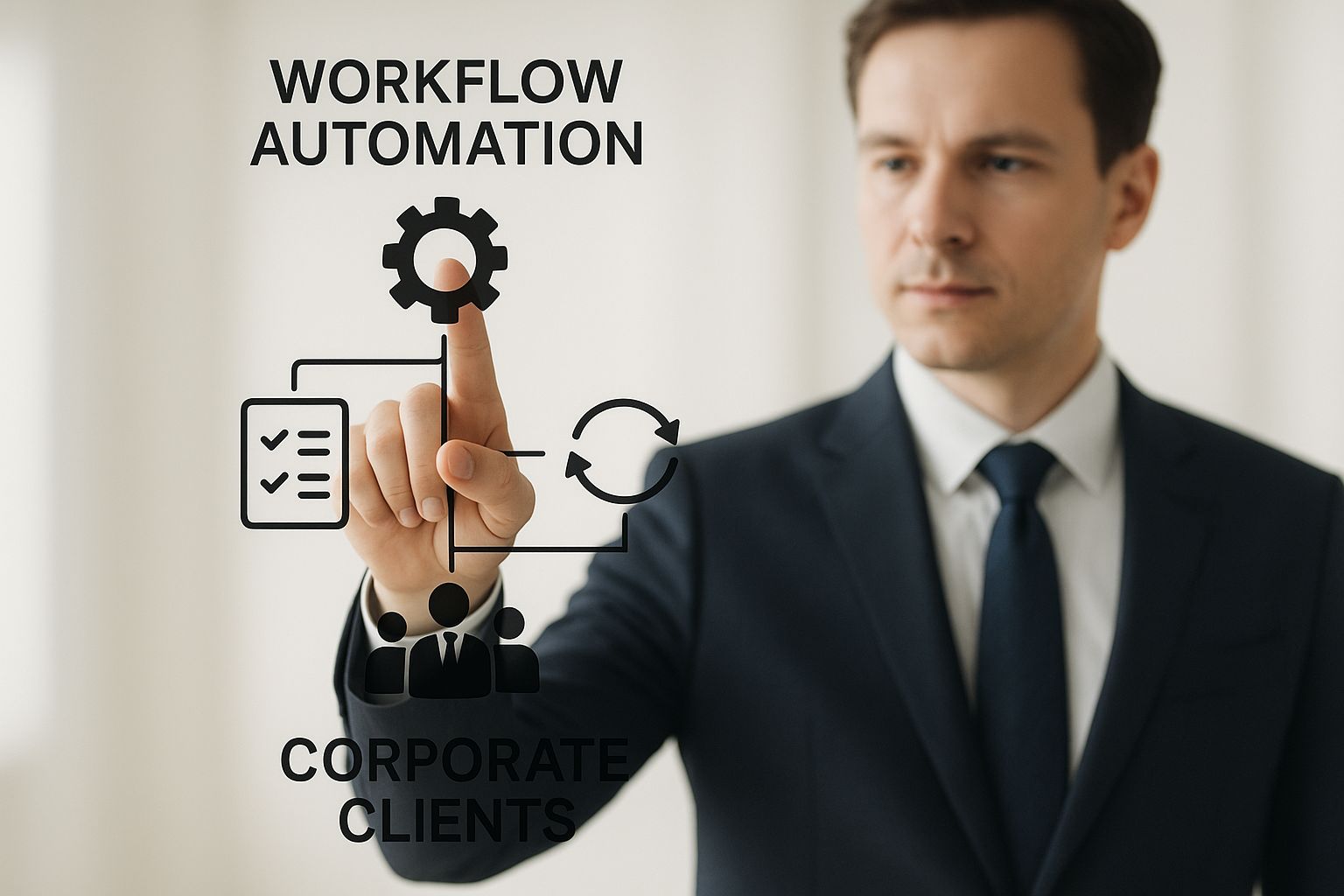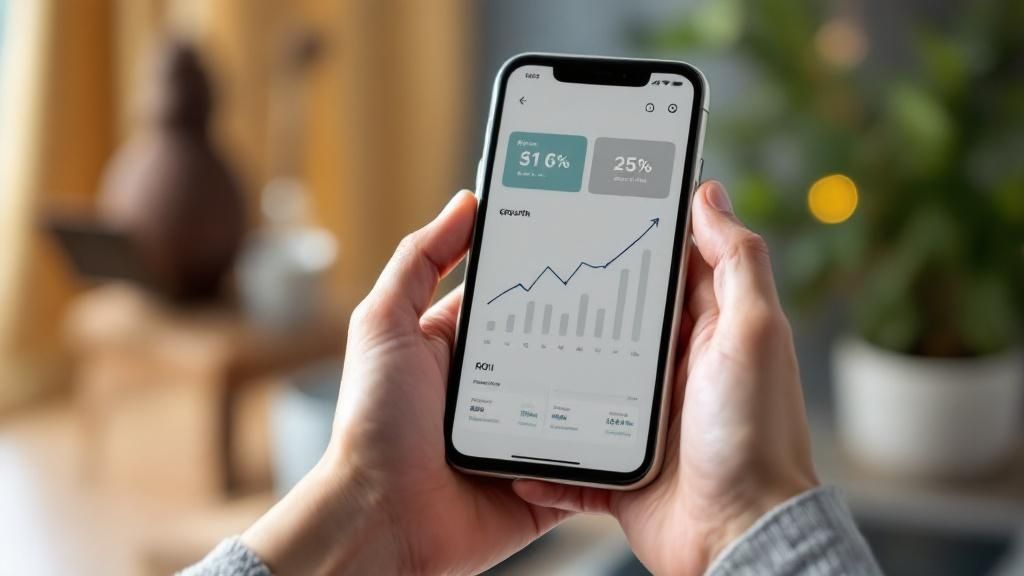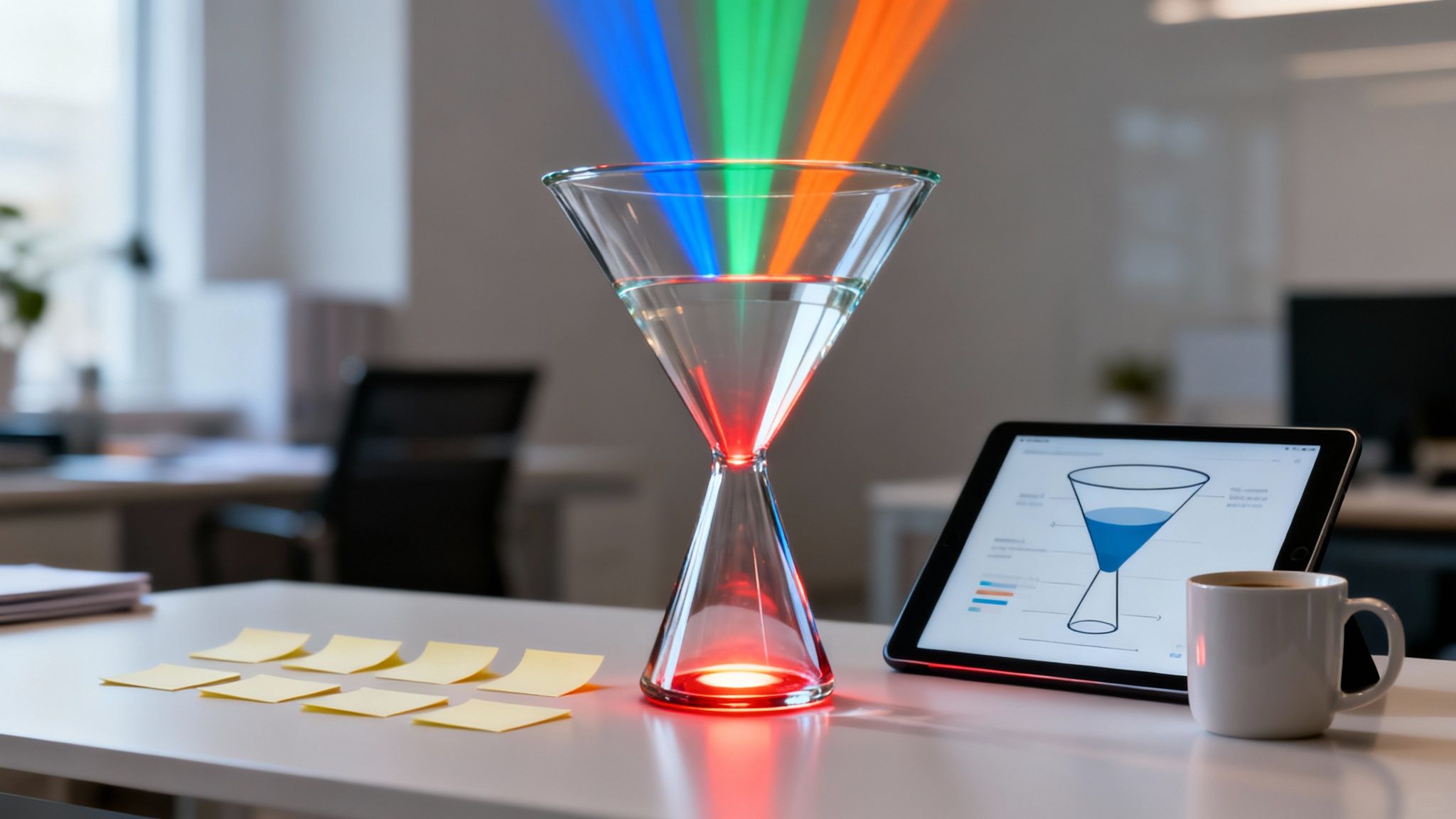Think of B2B marketing automation as your marketing team's ultimate assistant. It’s a sophisticated system designed to handle the repetitive, time-consuming tasks involved in guiding potential customers from their first visit to a final sale. This frees up your team to focus on what humans do best: strategy, creativity, and building genuine relationships.
What B2B Marketing Automation Really Means
At its heart, B2B marketing automation is about building a system that predictably generates revenue. It represents a significant leap from launching disconnected campaigns and hoping for the best. Instead of merely scheduling emails, you're creating a smart, responsive engine that engages potential clients throughout what are often long and complex sales cycles. It allows you to deliver personalized experiences based on what your prospects actually do, not just what you assume they want.
This isn't just a trend; it's a strategic response to modern business pressures. The marketing automation industry is projected to reach $15.62 billion by 2030 for a reason. Businesses are constantly stretched for time, money, and personnel. It's no surprise that 91% of decision-makers feel the push to automate more within their organizations. You can explore the rapid growth of marketing automation to see just how widespread this shift has become.
The Real Power of Automation
The true magic of a B2B marketing automation platform lies in its ability to give you back your team's most valuable asset: time. When the system is automatically sending follow-up emails, segmenting contacts, or scheduling social media posts, your people are free to tackle high-impact work—developing brilliant campaign ideas, analyzing performance data, and solving complex customer challenges.
This image illustrates how automation has become a central hub, connecting various business functions into a single, seamless workflow.

As you can see, it’s not about an isolated tool but an entire ecosystem working in concert to manage the customer relationship from the initial touchpoint to a signed contract and beyond.
How Automation Changes Your Day-to-Day
Implementing automation is a significant upgrade for your entire marketing operation. It centralizes your activities, provides clear data on what’s working, and ensures promising leads don't get overlooked. You stop guessing which leads are warm enough for a sales call because the system provides the data to prove it.
When executed correctly, marketing automation transforms your marketing department from a cost center into a predictable revenue driver. It provides the hard numbers needed to justify your budget and demonstrate tangible ROI.
The difference between manual and automated processes is night and day. Let's examine how some core functions are completely transformed.
Manual Marketing vs. Automated B2B Marketing
Ultimately, automation provides a level of scale and precision that is simply unattainable through manual effort alone. It ensures every potential customer receives a consistent, relevant experience, which is the key to winning their business in the long term.
Understanding Your Marketing Automation Toolkit
The best way to think about B2B marketing automation isn't as a single tool, but as a specialized workshop. You have different machines, each with a specific job, but they all work in sync to build something bigger: a steady, predictable pipeline of qualified leads. Let's open this toolkit and examine its core components.
At its heart, the entire system is designed to understand who your prospects are and guide them on their journey. Instead of manually tracking every click, download, and page view, the platform does it for you. This provides the intelligence needed to smoothly move potential buyers through their decision-making process.
Intelligent Lead Management
The true engine of any automation platform is its ability to manage leads intelligently. This is far more than a simple contact list; it boils down to two critical functions that work together to pinpoint your most promising prospects.
- Lead Scoring: This process assigns points to leads based on who they are (their job title, company size, industry) and their actions (downloading a whitepaper, visiting your pricing page). A high score is a clear signal that a prospect is not just browsing—they're a strong fit and actively engaged.
- Lead Nurturing: Once you've identified these promising leads, nurturing workflows take over. These are automated sequences of emails and other communications designed to educate and build trust over time. This keeps your brand top-of-mind, so when they’re finally ready to buy, you're their first call.
This one-two punch ensures your sales team spends its valuable time talking to people who are genuinely ready for a conversation, rather than chasing dead ends. It introduces a systematic, repeatable process to pipeline development.
Dynamic Email Automation and Landing Pages
We all know email, but B2B marketing automation transforms it from a broadcast tool into a dynamic, one-to-one conversation medium. Forget sending the same generic blast to everyone. Now you can build sophisticated campaigns that react and adapt to what each person does.
For instance, a SaaS company can use behavior as a trigger. If a prospect watches a demo about a specific feature, the system can automatically send a follow-up email with a case study about that exact function. This delivers a level of relevance that's impossible to achieve manually at scale.
The real power is in the synergy. A great email drives traffic to a high-converting landing page. That page captures lead information, which then fuels the automated scoring and nurturing workflows. Each component makes the others stronger.
These automated sequences are game-changers in industries with long, complex sales cycles. Consider a manufacturer selling heavy machinery, where a sale can take months or even years. They can set up a workflow that delivers educational content—technical specifications, ROI calculators, industry reports—at a steady pace. This keeps prospects engaged and builds the company's credibility long before a salesperson needs to pick up the phone.
Key Tools and Their Strategic Purpose
To fully appreciate how these elements work together, let's break down the core tools in the marketing automation toolkit and the specific job each one is designed to do.
These tools do not work in isolation; they form a cohesive system. The landing page captures a lead, behavioral tracking reveals their interests, the scoring model qualifies them, and the nurturing workflow builds the relationship. It’s this interconnected process that transforms your marketing from a collection of disparate activities into a unified, predictable revenue machine.
The True Business Impact of Automation
Let's focus on what truly matters: tangible business results. Beyond the sophisticated features and complex workflows, the real story of B2B marketing automation is about its direct impact on revenue. Your CEO and CFO aren't interested in email open rates; they want to see a clear, undeniable connection between marketing spend and company growth. Automation is the tool that draws that line.
It all starts by solving a common, persistent problem: lead quality. Instead of passing every new contact directly to sales, automation enables you to build intelligent nurturing programs. These systems educate and qualify prospects over time, warming them up long before a salesperson gets involved.
What does this mean for sales? It means the leads they receive are genuinely ready to talk. They are better informed, more engaged, and significantly closer to making a purchase. This shift prevents sales teams from wasting their most valuable resource—time—on leads that are going nowhere.
Fostering True Sales and Marketing Alignment
One of the most powerful outcomes of a well-implemented marketing automation system is that it finally breaks down the wall between sales and marketing. For too long, these teams have operated in different worlds, with separate goals, data, and definitions of a "good lead." Automation becomes the bridge that connects them.
Imagine a single platform where both teams see the exact same thing: a complete, real-time history of every prospect's journey. Marketing can see which campaigns are generating genuine interest. Sales can see every email opened, every link clicked, and every PDF downloaded before they even pick up the phone.
This shared intelligence is a game-changer. It smooths out the handoff process and eliminates friction.
- Marketing can finally prove its value, demonstrating precisely how its efforts are filling the pipeline with high-quality opportunities.
- Sales gets the crucial context needed to have smarter, more relevant conversations, which dramatically increases their close rates.
This synergy directly accelerates the sales cycle and drives more revenue. The conversation shifts from "marketing's leads are junk" to "how can we work together to close these hot leads?"
Driving Major Operational Efficiencies
Beyond generating better leads and aligning teams, automation brings massive operational efficiencies. Think about all the repetitive, manual tasks your team performs daily. Automation takes that work off their plate, freeing them to focus on what humans do best: strategy, creativity, and relationship building.
Automation transforms your marketing from a series of manual, disconnected tasks into a cohesive, streamlined system. This shift allows your team to focus on strategic thinking and creativity, rather than getting bogged down in administrative work.
The numbers support this. Companies that embrace automation report saving an average of 5 hours per week for each employee by taking routine tasks off their hands. They also see a 20% drop in human errors. Better yet, AI-powered sales teams are seeing a 10-20% increase in their return on investment, proving the direct link between smart automation and better financial performance. You can find more stats on how automation boosts sales productivity on Kixie.com.
Turning Marketing into a Revenue Center
Ultimately, the most critical impact is financial. B2B marketing automation provides the ability to track a customer's entire journey, from the first ad they saw to the final signed contract. This end-to-end visibility finally allows you to calculate the precise ROI on every dollar you spend.
You can now get concrete answers to your most important questions:
- Which channels are actually bringing in our most profitable customers?
- What was the exact revenue generated from our last webinar series?
- How long is the average sales cycle for a lead sourced from a trade show?
Having clear, data-driven answers changes everything. It means you can confidently invest more in what’s working, eliminate campaigns that aren't delivering, and make smarter budget decisions. While the methods for generating leads in B2B are unique, the need for clear ROI is universal. For more on this, see our guide on comparing B2B and B2C lead generation techniques.
This data-backed approach elevates the marketing department's role, proving its direct contribution to the bottom line and cementing its position as a core driver of business growth.
Why CRM Integration Is Not Optional
Treating your B2B marketing automation platform and your Customer Relationship Management (CRM) system as two separate entities is a critical mistake. They are not merely related; they are two halves of the same whole, designed to work in perfect concert.
Imagine your CRM as the central repository for your customer data—the system of record holding every critical piece of long-term information. Your marketing automation platform, then, is the active engagement layer, constantly capturing real-time behavioral signals like email clicks, content downloads, and website visits.
If that connection is weak or non-existent, crucial behavioral data never enriches the customer record. Integrating the two isn't just a "best practice"; it's the only way to build a complete, dynamic picture of your customer journey and eliminate the data silos that create friction between your sales and marketing teams.
Creating a Unified Customer View
The primary goal of this integration is to create a seamless, two-way flow of information. This constant synchronization ensures everyone in marketing and sales is working from the same playbook. The result is a true 360-degree customer view, where historical data is continuously enriched by real-time behavior.
This unified profile is a game-changer. It means a salesperson doesn't just see a name and a company; they see the whitepaper someone downloaded last week, the pricing page they viewed this morning, and the specific email that first captured their interest.
A disconnected system forces your teams to operate with blind spots. An integrated system provides the clarity needed for intelligent, relevant conversations that accelerate the sales cycle and build genuine trust with prospects.
This real-time intelligence empowers a sales team to succeed. Instead of making cold calls with minimal information, they can tailor every conversation to a prospect's demonstrated interests. A generic sales pitch becomes a helpful, timely consultation, which dramatically improves the odds of closing a deal.
The Most Critical Data Sync Points
While numerous data points can be synchronized, a few key connections are absolutely essential for a successful integration between your B2B marketing automation and CRM platforms. Each provides a specific benefit that ties directly to revenue growth. Of course, this all hinges on having the right CRM in the first place. You can learn more about choosing the right platform in our guide on using a CRM for business development.
So, what information needs to flow between the two systems? Let's break down the most important data syncs.
Key Data Syncs Between Marketing Automation and CRM
This table outlines the essential information that needs to move between your marketing automation platform and your CRM, and why each sync is so valuable.
Having these pathways open ensures both teams are always on the same page, armed with the most current and relevant information.
Enabling Precise ROI Tracking
Ultimately, integration is about accountability. When your systems are truly connected, you can finally track a customer's entire journey, from their first click on an ad to the final signed contract.
This allows you to answer the single most important question for any marketing team: "What was the return on our investment?"
Without that link, marketing reports on clicks and opens but cannot prove its impact on the bottom line. With it, you can draw a straight line from a closed deal all the way back to the marketing campaigns that sourced and nurtured it. This hard data empowers you to double down on what works, cut what doesn't, and finally turn marketing into a predictable revenue engine for your business.
Putting Your Automation Strategy Into Action
Understanding the tools and benefits is one thing, but successfully launching a B2B marketing automation strategy is another. It's easy to get excited about the technology, but moving from theory to practice requires a solid roadmap. Without one, that powerful platform you invested in can quickly become an expensive, underutilized piece of software.
The goal is to build a strategic framework that turns your investment into measurable results. This means focusing on the fundamentals before you launch your first automated campaign. Success doesn't start with the technology—it starts with clean data, great content, and a deep understanding of your customers.
Begin With a Clean Database
Let’s be direct: your automation platform is only as smart as the data you feed it. Starting with a messy, outdated, or incomplete contact list is like trying to build a skyscraper on a foundation of sand. It’s a recipe for failure.
Before migrating a single contact, take the time to perform data hygiene. This means removing duplicate entries, standardizing data formats, and segmenting your contacts into logical groups. This initial effort pays significant dividends later, ensuring your campaigns reach the right people with a message that resonates. A clean database is the bedrock for any meaningful personalization and accurate reporting.
Map the Complete Customer Journey
You cannot automate a journey you don't understand. Before building a single workflow, you must map out the entire customer lifecycle, from initial awareness to becoming a loyal advocate. This involves creating detailed buyer personas that go beyond basic demographics.
- Identify Pain Points: What specific problems are your ideal customers facing at each stage?
- Pinpoint Key Questions: What information do they need before they feel comfortable taking the next step?
- Define Touchpoints: Where are they interacting with you? Is it your blog, social media, a webinar, or an industry event?
This map becomes the blueprint for your automation, ensuring every email, notification, and piece of content is timely, relevant, and genuinely helpful.
A well-defined customer journey map turns your B2B marketing automation from a simple messaging tool into a strategic guidance system, gently steering prospects toward a solution.
This foundational work is precisely where smart businesses are focusing. A recent survey of B2B marketers found that 54% plan to moderately increase their automation budgets, and another 19% are planning significant increases. Their top priorities? Improving data quality and gaining a better understanding of their ideal customer profiles. This underscores how critical these initial steps are. You can check out more B2B marketing budget trends on MarketingProfs.com.
Build Your Content Library
Now that you understand the journey, you need the fuel to power it. Your content library is the engine that drives your nurturing campaigns. Every asset—from blog posts and whitepapers to webinars and case studies—should be created to answer a specific question or solve a particular problem at a specific stage of their journey.
Organize your content by persona and journey stage. This allows you to build automated workflows that deliver the perfect piece of content at the exact moment a prospect needs it most. With a solid content library, you're never scrambling for something valuable to share, helping you build trust and authority with your audience over time.
Define a Flawless Lead Handoff
Finally, you must build a solid bridge between marketing and sales. A clearly defined lead handoff process, powered by a smart lead scoring model, prevents high-quality leads from falling through the cracks. This isn't just a marketing task; you must build this model with the sales team to ensure universal agreement on what makes a lead "sales-ready."
Our guide on marketing automation implementation dives deeper into this critical step.
Establish clear, simple rules for when a lead is passed to sales and what information must accompany it. This alignment creates a seamless experience for the customer and provides the sales team with the context needed for a productive, successful conversation.
Got Questions About B2B Marketing Automation? We've Got Answers.
Even the clearest strategy can leave a few lingering questions. That's completely normal. When it comes to something as powerful as B2B marketing automation, you want to get it right. Let's tackle some of the most common questions we hear from B2B professionals.

How Do I Know If My Business Is Ready?
The classic sign you're ready for automation is when you start feeling growing pains. Is your team struggling to keep up with an influx of leads? Do you have limited insight into what prospects are doing before they talk to sales? If nurturing leads through a long, complex sales cycle feels like an uphill battle, it's likely time to consider automation.
Remember, automation is not a magic bullet. It works best when you already have a consistent flow of inbound leads and a solid content strategy. Think of automation as an amplifier—it takes what you’re already doing well and scales it, but it cannot create a marketing foundation from scratch.
What’s the Real Difference Between Automation and Email Marketing?
This is an excellent question. An email marketing tool is like a megaphone; it's fantastic for one-way broadcasts to a large list. A B2B marketing automation platform, however, is a comprehensive communications hub built for managing two-way conversations with thousands of individuals at scale.
It goes far beyond just sending emails. A true automation platform:
- Monitors user behavior across your website, landing pages, and other digital touchpoints.
- Uses that data to automatically segment your audience and score leads based on their engagement level.
- Initiates personalized journeys across multiple channels that adapt based on a person's actions.
- Integrates directly with your CRM, providing both sales and marketing with a single, unified view of every customer.
It works in concert to guide prospects from their first flicker of interest all the way to being genuinely ready for a sales conversation.
Many worry that automation will make their marketing feel robotic. When done right, the opposite is true. The goal is to make personalization possible on a large scale, so you're always delivering helpful, timely content that feels like it was created just for them.
What’s the Price Tag on B2B Marketing Automation?
You’ll find a wide range here, from a few hundred dollars a month to several thousand. The price typically depends on two main factors: the number of contacts in your database and the specific features you require.
However, don't focus solely on the monthly fee. Consider the total cost of ownership, which can include one-time setup fees, team training, and any ongoing support you might need. The real question is about return on investment. A good platform should pay for itself through improved efficiency, higher-quality leads, and, most importantly, measurable revenue growth. Top-tier systems like Microsoft Dynamics 365, which was named a Leader in the 2024 Gartner® Magic Quadrant™ for B2B Marketing Automation Platforms, demonstrate the value of the right tool.
Ultimately, the strategy, empathy, and great content still come from you and your team. The automation simply handles the heavy lifting of delivery, making every interaction feel personal and relevant.
Ready to build a predictable revenue engine with an automation strategy built just for you? The experts at Twelverays specialize in implementing data-driven marketing solutions that drive real growth. Discover how our digital marketing and CRM services can transform your business.
Related Marketing Automation Resources
B2B marketing automation success requires integration with comprehensive digital marketing strategies. Explore these related resources to maximize your automation impact:
- B2B Digital Marketing Strategies - Build comprehensive marketing programs that support automation
- Data-Driven Marketing Strategies - Use analytics to optimize automation performance
- Customer Segmentation Strategies - Personalize automated campaigns for better results
- B2B Marketing and Sales Alignment - Align automation with sales processes
By combining marketing automation with these strategic approaches, you'll create a comprehensive growth engine that drives consistent, scalable results.





